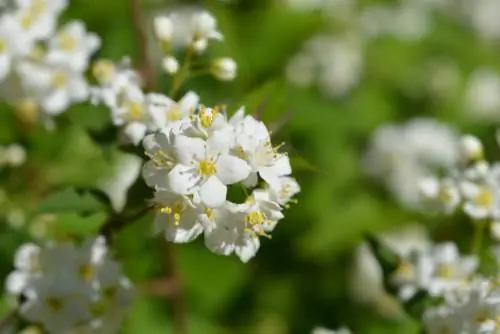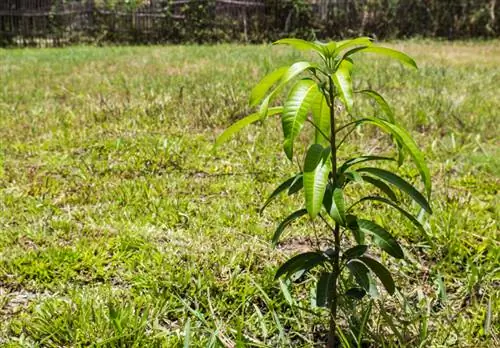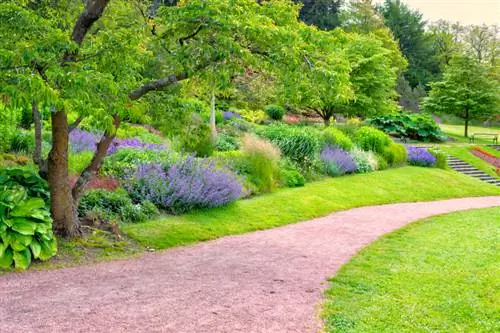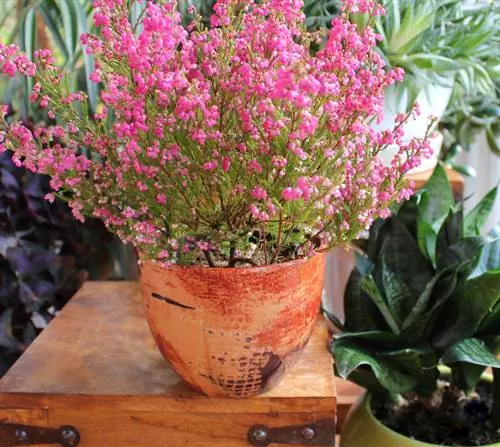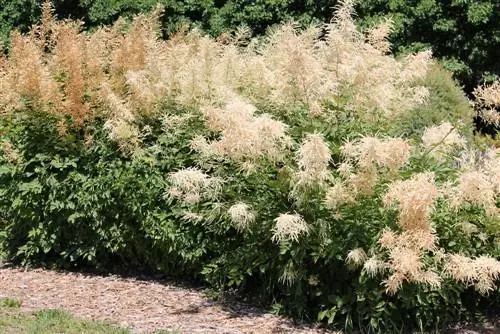- Author admin [email protected].
- Public 2023-12-25 17:45.
- Last modified 2025-01-23 11:22.
When picturesque flower clouds float over delicate green leaves, the May flower bush unfolds its spring-fresh potential. With Deutzien, the hydrangea family gifts us with fantastically beautiful ornamental trees that require very little from the gardener. The following answers to frequently asked questions convey what the flower beauty really values.
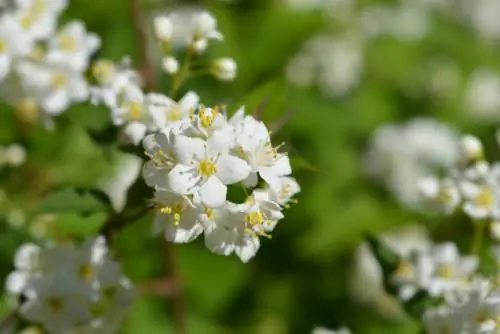
What is important when planting and caring for Deutzia?
Deutzia are easy-care ornamental trees from the hydrangea family that delight with picturesque flowers in white or pink in May and June. The best planting time is September and October, and a sunny, warm and wind-protected location with fresh, moist, nutrient-rich soil is ideal.
Planting Deutzia correctly
The best planting time for Deutzia is in September and October. Penetrated by the warming rays of the sun, the soil offers the best conditions for rapid rooting. As part of the preparation, soak the still potted root ball in water until no more air bubbles appear. The planting hole is dug spacious enough so that the previous planting depth can be easily maintained. Ideally, the excavation is optimized with compost and horn shavings (€52.00 on Amazon). If the Mayflower bush thrives in a large pot, insert a few pieces of pottery between the substrate and the bottom opening as drainage. The subsequent regular water supply is more relevant for Deutzia than the planting itself. You should preferably place a watering ring around the planting site so that the water cannot flow away to the side.
Care tips
It is a manageable care program that coaxes the fragrant clouds of flowers from a May flower bush. We have compiled all relevant aspects for you below:
- Water Deutzia abundantly and regularly
- Start fertilization in March/April with complete fertilizer
- Refertilize monthly until September with compost and horn shavings
- After the first flowering period, shorten by a third for autumnal re-blooming
- Throughly thin out the bush every one to two years and remove outdated branches
In pot cultivation, we recommend light winter protection so that the root ball does not freeze. Covered with foil and placed on wood, the ornamental tree survives the cold season he althy. In the bed, it is primarily delayed ground frosts that require adequate precautions. If there is a risk of frost, wrap the emerging branches with garden fleece or jute ribbons.
Which location is suitable?
They give a star bush all the trump cards for magnificent growth if the location is sunny and warm. To ensure that the picturesque flowers do not become disheveled, the chosen location should be sheltered from the wind. If the flat heart roots find fresh, moist soil, rich in nutrients and with first-class water drainage, the ornamental tree gives its best.
The correct planting distance
Due to the wide range of multi-faceted species, the specific planting distance must be tailored to the selected specimen. For orientation purposes, we have listed adequate distances for the most popular species and varieties:
- Deutzia gracilis: growth height 60-100 cm and growth width 50-80 cm - planting distance 30 cm
- Deutzia scabra: growth height 250-350 cm and growth width 180-200 cm - planting distance 100 cm
- Deutzia magnifica: growth height 200-300 cm and growth width 100-150 cm - planting distance 50 cm
What soil does the plant need?
As a flat, heart-rooted plant, the Mayflower bush depends on nutrient-rich soil that is humus and fresh-moist. However, waterlogging must not occur because Deutzia cannot survive this dilemma. Therefore, pay enough attention to the degree of permeability. If in doubt, loosen the soil with sand or fine grit.
When is flowering time?
The popular name Mayflower bush leaves no doubt when the hydrangea plant comes into its own. Look forward to opulent flowers in white or pink from May to June. If a slight pruning is carried out immediately after the first flowering period, this measure sets the stage for autumnal re-blooming in September.
Cut Deutzie correctly
Typical spring bloomers, such as Deutzia, are cut into shape immediately after flowering. If you shorten shoots that are too long by a third, with a little luck you can look forward to additional autumnal blooms. Place the scissors just above an outward-facing eye. This point of vegetation can be recognized as a slight bump under the bark. On this occasion, the May flower bush is carefully thinned out so that the light reaches all areas again. For this purpose, outdated and dead shoots are cut at the base.read more
Watering Deutzie
Deutzia are among the thirsty flowering shrubs. Never allow the plant to become drought-stressed, as it will not forgive it. The moisture content of the substrate is checked daily using a thumb test, especially during the flowering period. If the surface of the soil is dry, water it. Apply the water directly to the root disc, because overhead irrigation opens the door to infestation by cunning fungal spores.
Fertilize Deutzia properly
Deutzia only produces the opulent biomass of dense flower flora and lanceolate leaves when a sufficient amount of plant energy is available. A booster fertilization in April gets seasonal growth off the ground, followed by monthly replenishment in the form of compost and horn shavings (€52.00 at Amazon). The nutrient supply ends in September so that the shrub matures before winter.
Wintering
Deutzia are completely hardy when leafless. Only in the year of planting should the still young roots be covered with a layer of leaves or brushwood. If budding began in early spring, delayed ground frosts can affect this year's flower festival. Keep an eye on the weather forecast at this time to wrap the shoots in jute overnight if necessary. We recommend taking annual precautions against frosty temperatures in the pot. Wrap the container in bubble wrap and place a block of wood under it. The substrate receives a protective layer of leaves or coniferous twigs.
Propagate Deutzia
You can easily grow additional Deutzia using cuttings. If a May flower bush is full of sap, cut half-woody and non-flowering head cuttings. These are stripped of their leaves except for the upper pair of leaves and planted in a pot with poor soil. Rooting progresses quickly in a partially shaded, warm location. The top priority for a successful process is a sufficient supply of water without drowning the plant. By autumn you will have a vital young plant in your hands that can be planted out in the bed.read more
How do I transplant correctly?
The frugal starlet bush won't take offense if you tell it to change location. As long as the location is sunny, nutrient-rich and fresh and moist, growth will continue unhindered. In order to keep stress at the lowest possible level, the leafless season is the primary consideration. In autumn or early spring, cut off the root ball, lift it out of the ground and place it back in the new location without delay. It is important to note that the previous planting depth is maintained exactly.
Is Deutzia poisonous?
A look at the botanical classification of the hydrangea plant family gives the all-clear. The Mayflower bush is not poisonous. The magnificent ornamental tree is therefore an ideal candidate for the family garden where children and pets frolic.read more
Beautiful varieties
- Plena: Magnificent Deutzia scabra with double flowers, white on the inside and pink on the outside; Growth height 250-350 cm
- High May Flower Bush: Majestic ornamental tree with pure white flowers in dense umbel panicles; Growth height 200-300 cm
- Tourbillon Rouge: Pink Deutzia magnifica, whose flowers appear bordered in white; Growth height 200-300 cm
- Pink Pom-Pom: Slender beauty with hemispherical clusters in delicate rosé, later carmine pink; Growth height 100-200 cm
- Starshrub: Charming Deutzia gracilis with a delicate stature and white, simple flowers; Growth height 50-80 cm

